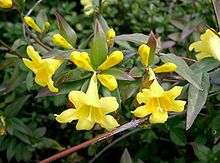Gelsemium sempervirens
Gelsemium sempervirens is a twining vine in the family Gelsemiaceae, native to subtropical and tropical America: Honduras, Guatemala, Belize, Mexico (Chiapas, Oaxaca, Veracruz, Puebla, Hidalgo),[3] and southeastern and south-central United States (from Texas to Virginia).[4] It has a number of common names including yellow jessamine or jasmine,[5][6] Carolina jasmine or jessamine,[5][6] evening trumpetflower,[6][7] gelsemium[6] and woodbine.[6]
| Gelsemium sempervirens | |
|---|---|
 | |
| Scientific classification | |
| Kingdom: | Plantae |
| Clade: | Tracheophytes |
| Clade: | Angiosperms |
| Clade: | Eudicots |
| Clade: | Asterids |
| Order: | Gentianales |
| Family: | Gelsemiaceae |
| Genus: | Gelsemium |
| Species: | G. sempervirens |
| Binomial name | |
| Gelsemium sempervirens | |
| Synonyms[2] | |
| |
Yellow jessamine is the state flower of South Carolina.[8]
Growth


_eating_Yellow_Jessamine_Flower.jpg)
Gelsemium sempervirens can grow to 3–6 m (10–20 ft) high when given suitable climbing support in trees, with thin stems. The leaves are evergreen, lanceolate, 5–10 cm (2–4 in) long and 1–1.5 cm (3⁄8–5⁄8 in) broad, and lustrous, dark green. The flowers are borne in clusters, the individual flowers yellow, sometimes with an orange center, trumpet-shaped, 3 cm (1 1⁄4 in) long and 2.5–3 cm (1–1 1⁄4 in) broad. Its flowers are strongly scented and produce nectar that attracts a range of pollinators.[3]
History
Some 19th century sources identified Gelsemium sempervirens as a folk remedy for various medical conditions.
Toxicity
All parts of this plant contain the toxic strychnine-related alkaloids gelsemine and gelseminine and should not be consumed.[9] The sap may cause skin irritation in sensitive individuals. Children, mistaking this flower for honeysuckle, have been poisoned by sucking the nectar from the flower.[10] The nectar is also toxic to honeybees,[11] which may cause brood death when gathered by the bees. The nectar may, however, be beneficial to bumblebees. It has been shown that bumblebees fed on gelsemine have a reduced load of Crithidia bombi in their fecal matter after 7 days although this difference was not significant after 10 days). Reduced parasite load increases foraging efficiency, and pollinators may selectively collect otherwise toxic secondary metabolites as a means of self-medication.[12]
The plant can be lethal to livestock.[13]
Despite the hazards, this is a popular garden plant in warmer areas, frequently being trained to grow over arbors or to cover walls.
References
- Tropicos, search for Gelsemium sempervirens
- The Plant List, Gelsemium sempervirens (L.) J.St.-Hil.
- Ornduff, R. 1970. The systematics and breeding system of Gelsemium (Loganiceae). Journal of the Arnold Arboretum 51(1): 1–17 includes description, drawings, distribution map, etc.
- Biota of North America Program 2014 county distribution map
- "Gelsemium sempervirens". Atlas of Florida Vascular Plants. University of South Florida. Retrieved 2008-02-12.
- "Gelsemium sempervirens". Germplasm Resources Information Network (GRIN). Agricultural Research Service (ARS), United States Department of Agriculture (USDA). Retrieved 2008-02-12.
- "Gelsemium sempervirens (L.) W. T. Aiton". Plants database. United States Department of Agriculture. Retrieved 2008-02-12.
- "South Carolina State Flower | Yellow Jessamine". statesymbolsusa.org. Retrieved 2019-10-15.
- "Gelsemium sempervirens". Drug Information Online. Drugs.com.
- Anthony Knight and Richard Walter. 2001. A Guide to Plant Poisoning of Animals in North America.
- "Nectar Gardening for Butterflies, Honey Bees and Native Bees", Retrieved 2012-08-02
- Manson, J.S., Otterstatter, M.C., Thomson, J.D. "Consumption of a nectar alkaloid reduces pathogen load in bumble bees". 27 August 2009: Oecologia 162:81-89. Retrieved 2013
- Niering, William A.; Olmstead, Nancy C. (1985) [1979]. The Audubon Society Field Guide to North American Wildflowers, Eastern Region. Knopf. p. 619. ISBN 0-394-50432-1.
| Wikimedia Commons has media related to Gelsemium sempervirens. |